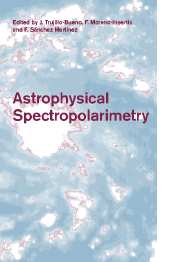Book contents
- Frontmatter
- Contents
- Participants
- Group Photograph
- Preface
- Foreword
- Acknowledgements
- The Physics of Polarization
- Polarized Radiation Diagnostics of Solar Magnetic Fields
- Polarized Radiation Diagnostics of Stellar Magnetic Fields
- Polarization Insights for Active Galactic Nuclei
- Compact Objects and Accretion Disks
- Astronomical Masers and their Polarization
- Interstellar magnetic fields and infrared-submillimeter spectropolarimetry
- Instrumentation for Astrophysical Spectropolarimetry
Polarization Insights for Active Galactic Nuclei
Published online by Cambridge University Press: 21 May 2010
- Frontmatter
- Contents
- Participants
- Group Photograph
- Preface
- Foreword
- Acknowledgements
- The Physics of Polarization
- Polarized Radiation Diagnostics of Solar Magnetic Fields
- Polarized Radiation Diagnostics of Stellar Magnetic Fields
- Polarization Insights for Active Galactic Nuclei
- Compact Objects and Accretion Disks
- Astronomical Masers and their Polarization
- Interstellar magnetic fields and infrared-submillimeter spectropolarimetry
- Instrumentation for Astrophysical Spectropolarimetry
Summary
Optical spectropolarimetry and broadband polarimetry in other wavebands has been a key to understanding many diverse aspects of AGN. In some cases polarization is due to synchrotron radiation, and in other cases it's due to scattering. Recognition of relativistically beamed optical synchrotron emission by polarization was vital for understanding blazars (BL Lacs and Optically Violently Variable quasars), both physically and geometrically. Radio polarimetry of quiescent AGN is equally important, again for both purposes. Scattering polarization was central to the Unified Model for Seyferts, Radio Galaxies and (high ionization) Ultraluminous Infrared Galaxies. It provides a periscope for viewing AGN from other directions. Finally, if we could understand its message, polarization would also provide major insights regarding the nature of the AGN “Featureless Continuum” and Broad (emission) Line Region.
I point out that high ionization ULIRGs have all the exact right properties to be called Quasar 2s. Mid-IR observations generally don't penetrate to the nucleus, greatly reducing their ability to diagnose the energy source. In particular, LINER ULIRGs aren't necessarily starburst-dominated, as has been claimed.
Seyfert Galaxies
Type 2 Seyferts
Polarization alignments and hidden Type 1 Seyfert nuclei
In the 1970s the continua of Seyfert 2s were decomposed into two parts: relatively red light from the old stellar population, and a bluer component modeled satisfactorily with a power law. The latter was called the “Featureless Continuum,” in a commendable attempt to avoid prejudice as to its nature.
- Type
- Chapter
- Information
- Astrophysical Spectropolarimetry , pp. 151 - 176Publisher: Cambridge University PressPrint publication year: 2001
- 9
- Cited by



